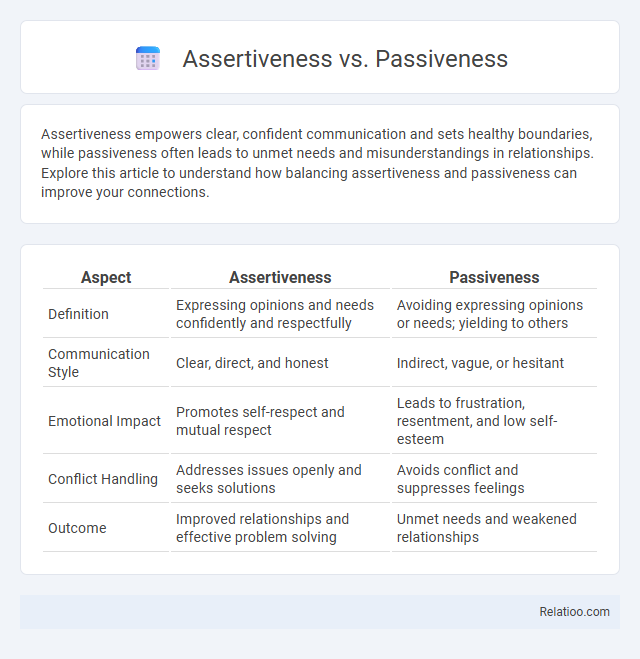Assertiveness empowers clear, confident communication and sets healthy boundaries, while passiveness often leads to unmet needs and misunderstandings in relationships. Explore this article to understand how balancing assertiveness and passiveness can improve your connections.
Table of Comparison
| Aspect | Assertiveness | Passiveness |
|---|---|---|
| Definition | Expressing opinions and needs confidently and respectfully | Avoiding expressing opinions or needs; yielding to others |
| Communication Style | Clear, direct, and honest | Indirect, vague, or hesitant |
| Emotional Impact | Promotes self-respect and mutual respect | Leads to frustration, resentment, and low self-esteem |
| Conflict Handling | Addresses issues openly and seeks solutions | Avoids conflict and suppresses feelings |
| Outcome | Improved relationships and effective problem solving | Unmet needs and weakened relationships |
Understanding Assertiveness and Passiveness
Understanding assertiveness involves recognizing your right to express thoughts, feelings, and needs confidently while respecting others. Passiveness, on the other hand, often leads to withholding opinions and allowing others to dominate, which can result in unmet needs and decreased self-esteem. Developing assertiveness empowers you to communicate effectively, set healthy boundaries, and build stronger relationships.
Defining Assertive Communication
Assertive communication involves expressing thoughts, feelings, and needs clearly and respectfully while maintaining personal boundaries. It contrasts with passive communication, which avoids expressing true feelings to please others, and aggressive communication, which violates others' rights through hostility or dominance. Mastering assertiveness enhances interpersonal relationships by promoting honesty, confidence, and mutual respect.
Characteristics of Passive Behavior
Passive behavior is characterized by a reluctance to express personal opinions, needs, or feelings, often leading to avoidance of confrontation and difficulty setting boundaries. It typically involves a tendency to prioritize others' desires over Your own, resulting in suppressed emotions and increased stress. Understanding these traits helps identify patterns that hinder effective communication and self-advocacy.
The Benefits of Assertiveness
Assertiveness empowers you to communicate your needs and boundaries clearly while respecting others, leading to improved relationships and increased self-confidence. Unlike passiveness, which may result in unmet needs and frustration, assertiveness fosters mutual respect and effective problem-solving. Cultivating assertiveness enhances your ability to express opinions honestly and handle conflicts constructively, boosting overall personal and professional growth.
Risks and Consequences of Passiveness
Passiveness often leads to missed opportunities and unmet needs, as individuals fail to advocate for themselves, resulting in decreased self-esteem and increased stress. This behavior can cause others to overlook or exploit them, generating resentment and damaging relationships over time. Chronic passiveness risks long-term mental health issues, including anxiety and depression, due to unresolved conflicts and suppressed emotions.
Common Misconceptions about Assertiveness
Common misconceptions about assertiveness include confusing it with aggressiveness or passiveness, when it actually lies between the two, promoting clear and respectful communication. Assertiveness involves expressing one's needs and opinions firmly yet respectfully, without infringing on others' rights, unlike aggressiveness which can be hostile and passiveness which often results in suppression of one's own voice. Understanding the true nature of assertiveness is crucial for effective interpersonal skills and healthy boundary-setting in both personal and professional contexts.
How to Recognize Passive Tendencies
Recognizing passive tendencies involves noticing behaviors where you avoid expressing your opinions, fail to set boundaries, or frequently apologize even when not at fault. Passive individuals often prioritize others' needs over their own, leading to suppressed emotions and unmet personal goals. By becoming aware of these patterns, you can work towards expressing your thoughts confidently and advocating for your rights effectively.
Strategies to Develop Assertiveness
Developing assertiveness requires clear communication techniques, such as using "I" statements to express your thoughts and feelings confidently without aggression or submission. Practicing active listening and setting healthy boundaries empowers you to stand up for your rights while respecting others. Role-playing scenarios and seeking feedback can enhance your assertive skills, transforming passiveness and aggressiveness into balanced, effective interpersonal interactions.
Real-Life Examples: Assertive vs Passive Responses
An assertive response involves clearly expressing feelings and needs while respecting others, such as saying, "I prefer the report by Friday to meet my deadlines." In contrast, a passive response avoids confrontation and may lead to unmet needs, like nodding silently when asked to extend work hours despite personal plans. Real-life examples highlight that assertiveness promotes effective communication and boundary-setting, whereas passiveness often results in frustration and resentment.
Building Confidence for Assertive Communication
Building confidence for assertive communication involves recognizing the distinctions between assertiveness, passiveness, and aggressiveness to establish healthy interpersonal boundaries. Assertive communication empowers individuals to express their thoughts and needs clearly and respectfully, which enhances self-esteem and fosters mutual understanding. Developing assertiveness skills such as active listening, maintaining eye contact, and using "I" statements significantly boosts confidence and reduces misunderstandings in personal and professional interactions.

Infographic: Assertiveness vs Passiveness
 relatioo.com
relatioo.com